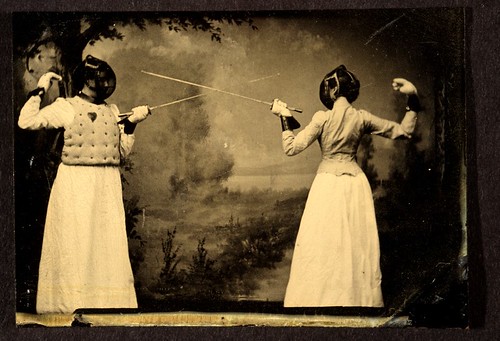
Two Women Fencing, Unidentified Artist, ca. 1885.

La Main de Madame Hugo, by Auguste Vacquerie, 1853-4.
These images are from the collection at the George Eastman House International Museum of Photography and Film in Rochester, New York. This collection is in the public domain—not copyrighted.
Being a lover of art and women’s history, I had to share some with you. Although the online collection spans years up to the mid-20th century, I picked out nineteenth century ones because, to me, it’s exciting to see photographic images of a time that far gone.
I’ve done a little online detective work to learn about who the subjects and/or photographers represented here were. That information is below in the large fonts.
The photo above, taken by the French photographer Auguste Vacquerie, must be of the hand of that Mme. Hugo—wife of Victor. Vacquerie was connected to the Hugo family through his brother’s marriage.
The image below by the English photographer Henry Peach Robinson supposedly depicts Viola from Shakespeare’s Twelfth Night. I found that out in a book about nineteenth century photographic theory and feminism, but…I was too tired really to understand what it said.
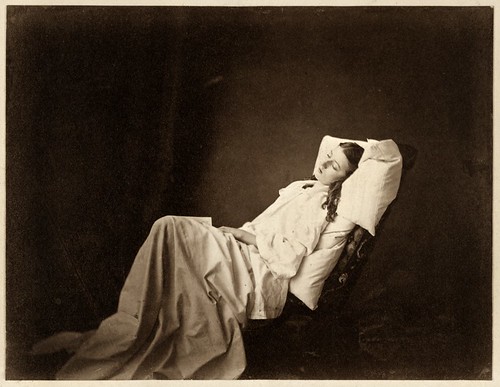
She Never Told Her Love, by Henry Peach Robinson, 1858.
The two photos below are by John Thomson, a Scottish pioneering photographer whose work among street people of London was a precursor to the field of photojournalism.
Being the passionate thrifter and clothes recycler that I am (I still have not bought any new clothes since last February), I was really fascinated with this one of the old clothes shop. I’ve never seen anything like it.
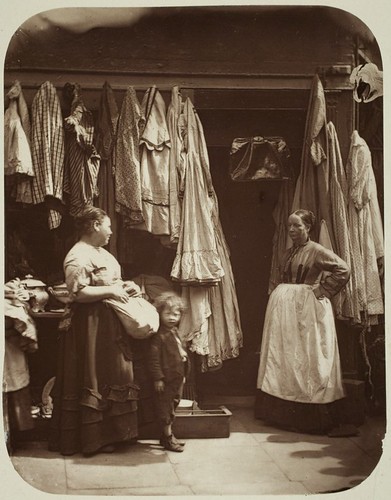
An Old Clothes Shop, Seven Dials, by John Thomson, 1876-7.
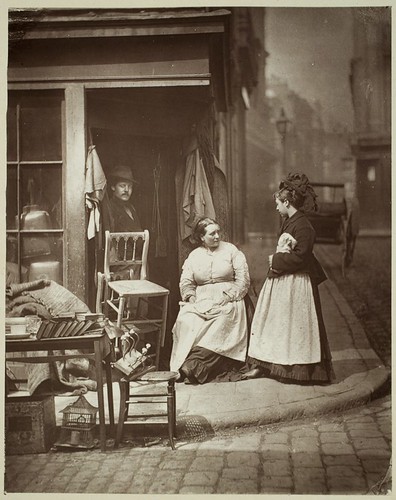
Old Furniture, John Thomson, 1877.
The photo below is titled “Petipa.” I’m quite certain the dancer is Mariia Surovshchikova-Petipa, who was prima ballerina to the St. Petersburg Imperial Theatres in the late 1800s. She was married to the choreographer Marius Pepita.
Interesting that in the fifth and sixth shots her arms are kind of at half-mast; not a true fifth position, and an unusual way to hold her hands (by today’s ballet standards).
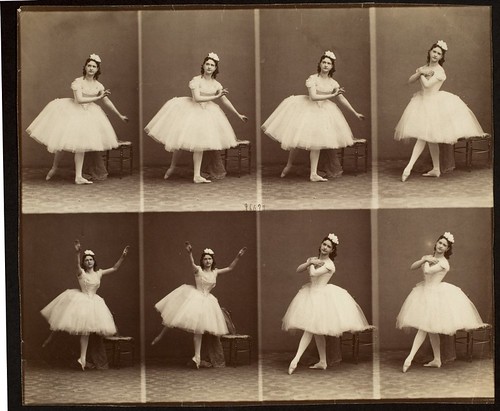
Petipa, Andre-Adolphe-Eugene Disderi, 1862.
The image below is by Julia Margaret Cameron, a British photographer from the Isle of Wight who found her art when she was 48 years old.
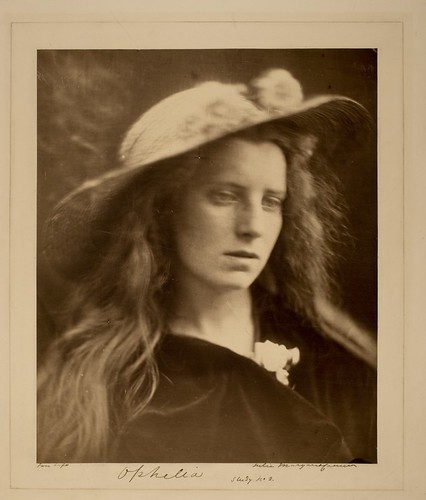
Ophelia Study, Julia Margaret Cameron, 1867.
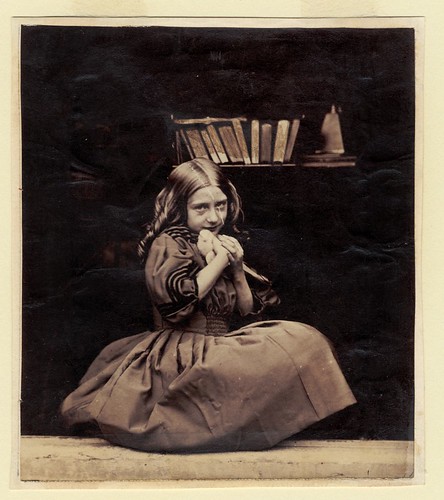
Girl With Dove, Oscar Rejlander, 1860.
The hand-tinted image below by early Japanese photographer Shin-E-Do looks like it could have been taken yesterday.
Shin-E-Do was known for depictions of Japanese life during the Meiji period (the last half of the nineteenth century)—a time of modernization and increasing status in the world.
I know little about how kimono and obi were traditionally worn, but I find it interesting that her obi is down around her hips, as in most of the images I’ve seen, it’s worn farther up the body. Maybe that was a style of the period? Or maybe her own personal style? Or…?

Japanese Woman With Mirrors, Shin-E-Do, 1890.
Aren’t these photos wonderful?
sallymandy

18 comments:
I feel like I've been to a gallery show! Lovely. I particularly liked the Cameron photograph.
Love all the sepia tones.
Lord, those are gorgeous images, Sallymandy - Like portraits in oil - You have selected such beauty to share with us, many, many thanks.
I also loved your post on making new things out of older clothing - I see you are still being very industrious... Can I share with you my sympathy for you and your family for your next, and necessary move? I know that, wherever you are, you will make a wonderful home, with energy and beauty... I wish you all well x
I love vintage photographs as they offer a view into history as it really was.
These images are very interesting, I particularly like the one of "Ophelia"; there is something very melancholic, almost haunting, in her eyes...
xo
Lovely photos! I'm always so intrigued by glimpses of women's daily lives during the 19th century.
The Japanese colored one interests me particularly, as I've come into possession of an entire album of them from the same period, supposedly presented to a great-great grandfather by the Japanese (emperor? government? navy?) after a US navy ship under his command saved those aboard a Japanese fishing vessel during a storm or something. The photos are of everyday Japanese life and scenes and are absolutely gorgeous.
Thank you, Bonnie! I was thrilled to find this collection and to learn that it's not copyrighted.
Fhina, thank you so much for your words of encouragement and support. I appreciate them dearly.
Protege: I like the Ophelia shot, too. It's unusual, I think, to have such a casual and candid shot from that time period, when often people were buttoned up and formal--especially women weren't often seen with hair around their shoulders.
Deja: that's just fascinating. What a treasure for your family!
Wonderful, indeed!
I've recently discovered some of these images on flickr commons and
have had such fun including many in my altered art. You might also enjoy some of the images from the New South Wales Collection.
Excellent post ... . .
Jjjj
Wonderful photos, I agree! And even more amazing that you haven't bought any new clothes since February!
So many of these look like film or theatre shots, which I suppose makes sense - sources such as these are the research we seek when making films or theatrical productions about the past.
This post is fun, instructive, and creative. Loved the photographic history tied to women's history.
They are! Truly a treat, thank you so much. I think "Old Furniture" and "Ofelia Study" are my favorites. The last picture prompts images of a geisha preparing for tea ceremony... perhaps Japanese courtesans wore the obi doen low... See what your posts do to me? They trigger my fantasy!
Ciao lovely
Lola xx
I love these photos. Thanks for showing them. Are they online somethere? I'd like to see more.
Wow. I find myself plunged into history and photo and something more I can't quite identify. Wonderful share! thanks.
erin
Loved this post! Thank you bringing these amazing photos to our attention. x
Thanks for your kind comments on my blog. I love the photos in this entry-- especially of the girl in the kimono.
Judith: Thanks for the tip about the other photos you found.
Stephanie: One can learn so much about the past and fashions through sources like this.
Lakeviewer: Thanks. It's heartening to think that if these women were in clothes like ours (and hairstyles), they'd look just like we do. I love that historical connection too.
Lola dear: they trigger my fantasies, too...and sometimes we need that! :)
Marilynne: You can find them by clicking on the green link in the first paragraph of the post.
WiW: thanks! Glad you liked them...nice to have you back.
NSM: Absolutely. A lot of us like the same kinds of things, no?
Leicia: Thanks for stopping by! The kimono girl is really striking.
These are all rare and lovely in their own right but I especially fancy the ballerina and the little girl with the dove. Lovely in an eeiry sort of way.
That hand tinted photo is amazing.
I love old photos!!
xoxo
This is late but I thought I'd chirp in. If I'm not wrong, that style of wearing the kimono indicates that the lady is a geisha. Geishas wear the kimono differently from other women notably the lower obi and the space between collar and neck. If you look at the collar carefully you can see that it isn't flush against the neck/shoulders.
Post a Comment